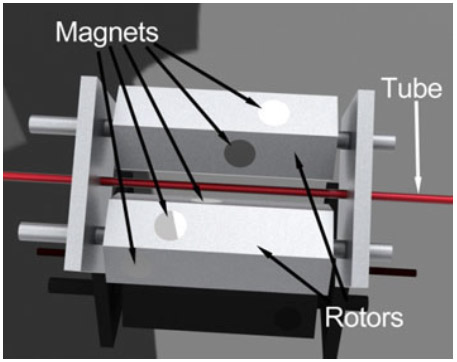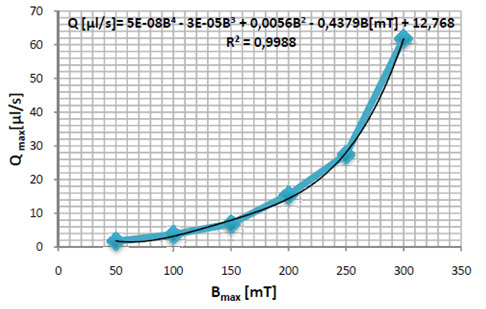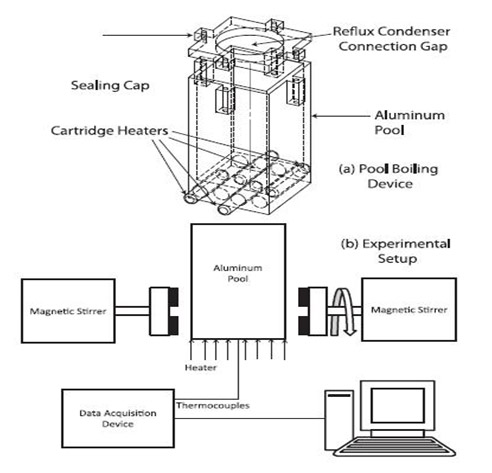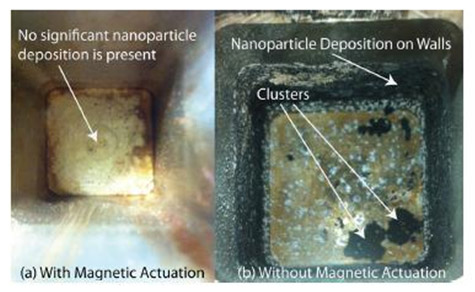Magnetic actuation of ferrofluids with dynamic magnetic fields is one of the most important and promising research areas in biomedical and chemical analysis of microfluidics. Since, effective micropumping is a must for actuation of the sample into the microfluidics systems, magnetic actuation of the magnetic fluids can be used for this purpose. Our goal is in this project, achieving the high flow rate, portable and entegrable micropump design as well as to better understand the magnetic actuation by modeling of the system.

In many actuation techniques, there are some limitations such as low flow rate, moving parts, requirement of high voltage. Additionally, most of them generates undesired effects on cell and proteins. This type of magnetic pumping technique could be used for various medical applications, including drug or hormone (e.g. insulin) infusion pumps, highly controllable intravenous liquid administration, accurate mixing of drugs.
In microsystems and lab on a chip applications, pumps are the main component of the fluidic system to deliver an assay to desired locations. But since conventional pumps are not suitable for micropumping applications, efficient micropumping technologies need to be investigated.


A device producing varying magnetic field and thus actuating ferrofluids was designed and implemented. The magnet holders were placed in a frame and rigged to turn in the same direction with the same angular velocity. A plastic transparent mini channel was placed in between magnet holders, which contains the ferrofluid. With the rotation of the magnet holders, displacement of the ferrofluid was observed and the volumetric flow rate of the ferrofluid was obtained for different angular velocities of the magnet holders. Actuation was realized with a simple DC motor. The angular velocities were calculated from position data obtained from motor’s encoder. Experiments were repeated for over 20 times and to ensure the reliability of the results, the gathered data was averaged.

Significant flow rates could be attained using this technique so that it could be stated that this type of magnetic pumping technique can be a significant alternative for widely used techniques such as hydrodynamic, electrokinetic and piezoelectric actuation techniques.
The concept was also utilized for heat transfer enhancement with ferrofluids in a pool with varying magnetic fields. An average heat transfer coefficient enhancement of 37.5% was achieved with the magnetic actuation. Magnetic actuation could prevent clustering and sedimentation of the nanoparticles, which is undesirable in most cases.
References:
Kurtoğlu, E., Bilgin, A., Acar, H.F.Y., and Koşar, A., "Development of magnetic pumps based on ferrofluid actuation with varying magnetic fields for micropumping applications", Micro-fluidics Nanofluidics, 13, pp. 683-694, 2012.
Sesen, M., Sendur, K., Menguc, M.P., Yagci, Acar, H.F., and Koşar, A.,"A Heat Removal System with the Actuation of Magnetic Nano-particles ," Journal of Applied Physics, 112, 064320, 2012.
Sesen, M., Teksen, Y., Şahin, B., Sendur, K., Menguc, M.P., Yagci, Acar, H.F., and Koşar, A.,"Boiling Heat Transfer Enhancement of Magnetically Actuated Nanofluids," Applied Physics Letters, 102(16), 2013.
Kurtoğlu, M., Kaya., A., Gozuacik, D., Yagci Acar, H.F., and Koşar, A., " Experimental Study on Heat Transfer Performance of Iron oxide Based Ferrofluids to be Used as New Genera-tion Coolants and Drug Delivery Agents," ASME Journal of Thermal Science and Engi-neering Applications, 6(3),034501, 2014.